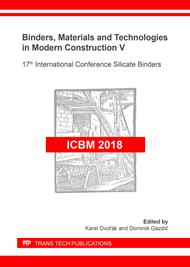[1]
Sitek, L., Foldyna, J., Martinec, P., Scucka, J., Bodnarova, L. and Hela, R., Use of pulsating water jet technology for removal of concrete on repair of concrete structures, Baltic journal of road and bridge engineering. 4(6) (2011) 235 - 242.
DOI: 10.3846/bjrbe.2011.30
Google Scholar
[2]
Hlavac, L., Bodnarova, L., Janurova, E. and Sitek, L., Comparison of continuous and pulsing water jets for repair actions on road and bridge concrete, Baltic journal of road and bridge engineering. 7(1) (2012) 53 - 59.
DOI: 10.3846/bjrbe.2012.08
Google Scholar
[3]
Bodnarova, L, Hroudova, J., Brozovsky, J. et al., Behaviour of Cement Composites with Lightweight and Heavyweight Aggregates at High Temperatures, Periodica Polytechnica-Civil Engineering. 61, 2 (2017) 272-281.
DOI: 10.3311/ppci.9365
Google Scholar
[4]
Sucharda, O., Brozovsky, J. and D. Mikolasek, Numerical Modelling and Bearing Capacity of Reinforced Concrete Beams, Advances in fracture and damage mechanics XII, Key Engineering Materials. 577-578 (2014) 281-284.
DOI: 10.4028/www.scientific.net/kem.577-578.281
Google Scholar
[5]
Momber, A., Fluid jet erosion as a non-linear fracture process: a discussion, Wear. 250 (2001) 100-106.
DOI: 10.1016/s0043-1648(01)00615-9
Google Scholar
[6]
Guzii, S., Hela, R. and V. Kirichok, Rehabilitation of concrete surfaces of hydropower engineering structures deteriorated by soft corrosion and cavitation, Advanced Materials Research, 688. (2013) 107-112.
DOI: 10.4028/www.scientific.net/amr.688.107
Google Scholar
[7]
EN 12350-2, Testing fresh concrete - Part 2: Slump-test, European Committee for Standardization (2009).
Google Scholar
[8]
EN 12350-6, Testing fresh concrete - Part 6: Density, European Committee for Standardization (2009).
Google Scholar
[9]
EN 12350-7, Testing hardened concrete - Part 7: Density of hardened concrete, European Committee for Standardization (2009).
Google Scholar
[10]
EN 12350-3, Testing hardened concrete - Part 3: Compressive strength of test specimens, European Committee for Standardization (2009).
Google Scholar
[11]
EN 12390-5, Testing hardened concrete - Part 5: Flexural strength of test specimens, European Committee for Standardization (2009).
Google Scholar
[12]
EN 12390-6, Testing hardened concrete - Part 6: Tensile splitting strength of test specimens, European Committee for Standardization (2010).
DOI: 10.3403/02128962
Google Scholar
[13]
CSN 73 1318 1987, Determination of tensile strength concrete (Stanoveni pevnosti betonu v tahu in Czech), Office for standardization and testing (1987).
Google Scholar
[14]
Hu, X.G., Momber, A.W., Yin, Y., Wang, H. and D.M. Cui, High-speed hydrodynamic wear of steel-fibre reinforced hydraulic concrete, Wear. 257 (2004) 441-450.
DOI: 10.1016/j.wear.2004.01.019
Google Scholar


